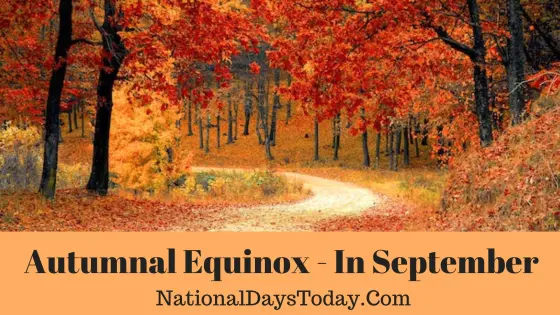Autumnal Equinox
Autumnal Equinox:
Seasonal transition is ushered in by the Autumnal Equinox in September. Every year, people mark the day when the sun is directly above around the equator.
| Year | Date | Day | Where |
| 2023 | 22nd September | Friday | United States |
| 2023 | 22nd September | Sunday | United States |
| 2025 | 22nd September | Monday | United States |
Twitter Hashtags:
#AutumnalEquinox
Related: Other National Days Celebrated on September 22nd:
Why Autumnal Equinox:
The autumn equinox is one of only two days when the sun rises and sets directly above at all points on Earth, excluding the polar caps. All latitudes experience 12 hours of sunshine and 12 hours of darkness, with very few exceptions.
While Labor Day is recognized as the formal end of summer in the US, the seasons have their own ways of keeping track of time. The plants and animals respond differently depending on the quantity of sunshine they receive depending on where we live. The leaves have already started to change in several areas of the country by the time the equinox occurs in September. At night, the air is more crisp.
On the day of the fall equinox, each new year began at midnight. Each month was given a natural element in an attempt to revolutionize the calendar and purge it of any religious or royalist influences.
How To Observe Autumnal Equinox:
People start to consider wearing warmer clothing and getting ready for winter in their houses. Most summertime activities are over now that kids are back in school. Farmers excitedly wait for the right moment to harvest in the fields. In the gardens and orchards, apples, pumpkins, and root vegetables begin to mature. Long walks around the paths in the shade of canopies of gold, umber, violet, and red keep us warm on chilly evenings.
Take a lengthy stroll. enjoy a cup of tea or the sunset. Autumn has begun. Post on social media with the hashtag #AutumnalEquinox.
Interesting Facts of Autumnal Equinox:
- The astronomical event known as the autumnal equinox signals the beginning of autumn (or “fall”).
- As the amount of sunshine drops, plants and trees slow down in preparation for the upcoming colder season. Asters and chrysanthemums are in full flower in the yard, and there are plenty of orange pumpkins and corn mazes.
- Everywhere on Earth, dawn and sunset occur exactly 12 hours apart on the autumnal equinox. The word “equinox” really derives from the Latin word “equinoxium,” which denotes parity between day and night.
- The autumnal equinox causes biological changes in animals. Animals in the Northern Hemisphere should start preparing for the cold winter by eating more, relocating, or finding a place to hibernate when the quantity of sunshine decreases.
- The Harvest Moon is a full moon that occurs just before the fall equinox.
- China holds a holiday called the Mid-Autumn Festival to commemorate the fall equinox.
- In the Southern Hemisphere, where it is known as the vernal or spring equinox, astronomers see the September equinox as the start of spring.
- In actuality, most locations on Earth get to see more than 12 hours of daylight today. This is due to two factors: the definition of dawn and sunset, and atmospheric light refraction.
- There are two times a year when places that are not on the equator experience equal day and night, generally a few days before or after the equinoxes. Those who live closer to the equator observe this occasion, also known as the equilux, a few days before the equinox.
History Of Autumnal Equinox:
The fall equinox has always signaled the end of one season and the beginning of another. Calendars, beliefs, practices, civilizations, traditions, and much more have all been impacted by it.
The fall equinox, also known as the autumn equinox, occurs in 2019 on September 23. | Although it usually occurs between September 21 and September 24, the fall equinox is not on the same day each year. In the Northern Hemisphere, it is the start of fall. The September equinox marks the start of spring in the Southern Hemisphere, which is true in reverse.
The autumnal equinox has long been a cause for celebration. The autumnal harvest corresponds with the equinox of September in the Northern Hemisphere, and several historic harvest festivals are held on or near this day.
The terms “equinox” and “nox,” which refer to night and equal in Latin, are related. Nearly everywhere on Earth, day and night are of roughly equal length on the equinox.
The title of the Earth as it revolves around the sun remains constant. The North Pole is slightly inclined toward the sun for about half of the year, lengthening the days in the Northern Hemisphere, while the South Pole is slightly slanted away from the sun, shortening the days in the Southern Hemisphere.
The North Pole is then slightly tilted away from the sun while the Earth keeps rotating around the sun at its constant angle. The equinox is the time of year when this change takes place, and on this day, rather than being at a position north or south, the region of Earth closest to the sun is the equator.
The September equinox is the first day of fall in the Northern Hemisphere. In the Southern Hemisphere, on the other hand, the September equinox marks the start of spring.
Every agricultural society I’ve read about honored the previous year’s crop. The majority of events took place on October 31—Halloween or Samhain—between the Autumnal Equinox and that day. The Anglo-Saxon term “haerfest,” which was used to describe autumn, is where the word “harvest” originates. It has evolved to signify the period of year when grain and other crops are ready for reaping and collection.
Grain stalks were bound together and burnt in ancient Northern Europe as a sign of the Harvest Lord. The soil was covered in the ashes. The reapers would exclaim, “We have the Kern!” as they created the Crop Queen, also known as the Kern Baby, from the final sheaf of the harvest. The sheaf was draped in a spring-themed white garment with multicolored ribbons and hung from a pole.


